
Original Link: https://www.anandtech.com/show/2070
ASUS P5B: New BIOS Adds Unlocking & Improved Overclocking
by Wesley Fink on August 24, 2006 3:00 PM EST- Posted in
- Motherboards
The introduction of Core 2 Duo about a month ago delivered a new processor with about a 25% improvement in performance over the fastest chips in the market. The top-line X6800, running at 2.93GHz, was the most flexible of the new processors, with completely unlocked multipliers up and down. This allowed settings like running at a 13x multiplier (stock is 11x) at 277 FSB (3.6GHz) at default voltage - the result of the incredible head room exhibited by the new Conroe processors.
| Intel Core 2 Processors | |||
| CPU | Clock Speed | L2 Cache | Price |
| Intel Core 2 Extreme X6800 | 2.93GHz | 4MB | $999 |
| Intel Core 2 Duo E6700 | 2.66GHz | 4MB | $530 |
| Intel Core 2 Duo E6600 | 2.40GHz | 4MB | $316 |
| Intel Core 2 Duo E6400 | 2.13GHz | 2MB | $224 |
| Intel Core 2 Duo E6300 | 1.86GHz | 2MB | $183 |
Unfortunately, the X6800 costs $999 which is way out of the budget range for many buyers - and it's even more at retail right now due to demand and availability, with the best price we're currently tracking at $1150. The good news is the lowest-priced E6300 outperformed every previous Intel chip. Compared to AMD the E6600 outperformed every AMD processor, and costs $364 to $433 compared to the $825 to $950 for the AMD top-line FX-62. (Almost all of the Core 2 processors are being marked up 10% to 20% at retail, though we expect prices to drop over the coming months.)
So is there a catch? The answer is yes and no. The X6800, as stated, is unlocked up and down, allowing the flexibility to do anything you wish with the outstanding head room of the Core 2 Duo architecture. The rest of the Core 2 Duo chips are hard-locked up and down, which greatly limits the flexibility of the head room which often runs 1000MHz, 1500 MHz, or more - depending on the CPU and motherboard. You could only access this extra power at the stock multiplier. This is actually a big negative compared to AM2 processors, where all chips are at least unlocked down.
ASUS has a history of incredible creativity in their mainstream motherboards. Those who recall the P865 Springdale will remember ASUS was the first to implement the "875 only" PAT speedup on the mainstream 865 - making the 865 just as fast as the more expensive 875. On the 925, where Intel had implemented a clock lock, ASUS was the first to find a way to break the clock lock and unleash extended speeds on their 875 motherboards. With this history in mind, it should not come as a surprise that ASUS has just introduced some very creative thinking in a new BIOS for their 965P chipset P5B Deluxe motherboard.
The new 0507 BIOS for the P5B Deluxe, dated 8/10/2006, has two new and exciting features:
- Provide better maximum overclocking.
- Add the ability to adjust the multiplier of most Conroe CPUs even if they are not Extreme Edition.
Even more exciting is that ASUS says they have found a way to unlock up or down most Conroe chips. This will be a significant new feature that is highly desired by many Core 2 Duo buyers. It didn't take but a few minutes for us to get the new BIOS flashed and a Core 2 Duo chip mounted to check this out.
A pattern has been developing for some time in test results from Core 2 Duo chips. The 2MB Cache chips, the E6300 and E6400, are generally overclocking a bit better than the 4MB E6600, E6700, and X6800 chips. Since performance of the 2MB is a bit lower than the 4MB cache at the same frequency, this means you can make up for some of the 2MB cache deficiency with the ability to run at a faster speed. With this in mind, testing was performed with all 4 of the Core 2 Duo chips that are multiplier locked - the 4MB E6700 and E6600, and the 2MB E6400 and E6300.
E6700
The 0507 BIOS adds a new feature in the BIOS under the "Advanced", "CPU Configuration" tab. Where there was no means to adjust CPU ratios in earlier BIOS versions, with 0507 you now have an adjustment range from 6X to 10X.
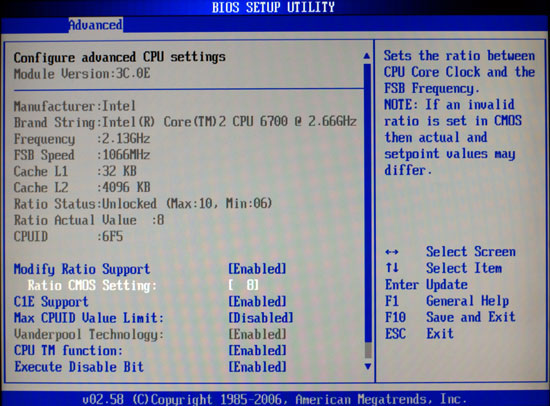
Some Conroe chips also unlock at the top, allowing ranges to about 14x. None of our Conroe chips unlocked up, but you may be one of the lucky ones who have a Conroe that unlocks both down and up.
The E6700, which runs at 2.67GHz, is very interesting because of the large headroom we consistently find at stock voltage. Once again, on the P5B Deluxe at stock voltage, the combo could run day and night at 3.4GHz (340x10) with no issues at all. At the stock multiplier of 10x, at 1.4875V the highest stable speed was 360x10 or 3.6GHz, At a reduced 9x the highest speed was 400x9, which is also 3.6GHz. With the new BIOS unlocking multipliers down, we reached 440 at 8x, or 3.52Ghz, as you can see in this screen capture.
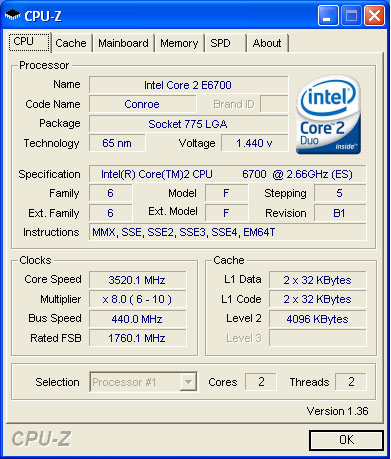
7x allowed a further increase to a FSB speed of 494, which is where the 6700/P5B maxed out. Even at a 6X multiplier 494 seems the limit of the FSB with this CPU and board. Comparing this to our highest FSB overclock of 362 with this board in the Conroe Buying Guide we would conclude that ASUS has significantly improved the overclocking of the P5B. The ability to choose and hold lower multipliers allowed the bus speed to increase from 360 to 494.
E6600
The E6600 unlocked down with the new BIOS and allowed a new range of FSB adjustments of 405x9 (stock), 460x8, 495x7, and 495x6. Below is a screen capture at 495x7 or 3.465GHz.
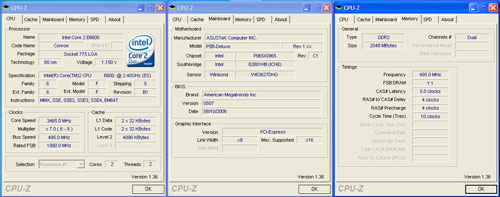 |
| Click to enlarge |
While the new BIOS on the P5B adds enormous flexibility to the 965P motherboard, it should still be pointed out that on average the 965 still does not overclock as well as the Intel 975X if you compare clock to clock. You might want to look back at the 975X overclocking results in Conroe Buying Guide: Feeding the Monster for a comparison.
As more experience has been gained in overclocking Core 2 Duo chips, it is becoming clear that the 4MB cache E6700 and E6600 do not overclock quite as well as the 2MB Cache chips. There is not a huge difference in the overclocking of 2MB and 4MB at each multiplier, but there is a small advantage to the 2MB design for overclocking. Keep in mind, however, that 2MB performance is lower, so that tends to offset any advantage the 2MB E6400 and E6300 designs might enjoy.
E6400
The E6400 starts at 8x266 or 2.13GHz. With the new 507 BIOS we managed to reach stable speeds of 445x8, 511x7, and 514x6. This composite should give you a better idea of performance at a FSB of 445x8. There is a huge amount of capture information in this image, so you will need to click to enlarge it to readable size.
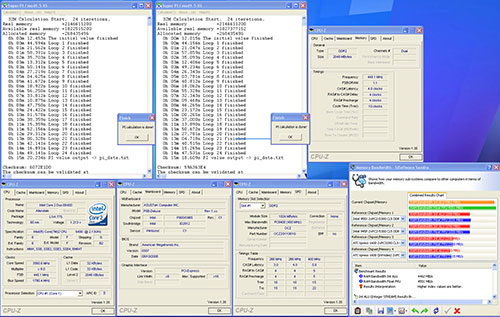 |
| Click to enlarge |
The jump from 2.13GHz to 3.58GHz is an amazing overclock of 1449MHz, or almost 1500 MHz. Percentage wise, this is a bit more than 68%. With the new ASUS BIOS, we now have the ability to do similar overclocks with the bus speed. With the 6400 the bus speed can now be adjusted from 266 to 514, which represent s a potential bus speed overclock of 93% - almost double the stock 266 FSB speed.
E6300
At $183 the E6300 represents the best value among the Core 2 Duo processors. The 65nm architecture combined with a low starting speed of 1.83GHz presents buyers with some amazing overclocking potential. These capabilities are enhanced further with the ASUS 0507 BIOS.
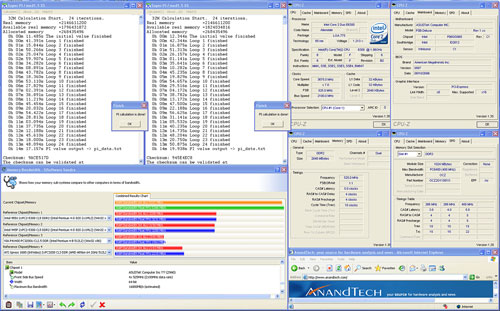 |
| Click to enlarge |
The E6300 unlocked down and reached 525x7 at stock multiplier. We were very near the limits of the ASUS P5B with the new BIOS and Scythe Infinity air cooling since dropping to x6 only gained us a few more MHz on the FSB, namely 532 at 6X. This is a100% bus overclock and it clearly demonstrates the added flexibility of the lower speed Core 2 Duo chips.
While the 2MB cache E6400 and E6300 reached higher bus speeds and CPU clocks than the 4MB E6700 and E6600, keep in perspective that the 4MB versions perform faster clock for clock. Any advantage the 2MB might have in our testing is small and is more than offset by the 4MB performance advantage. Still, the 2MB models are definitely impressive overclockers and they are both excellent values in the Core 2 Duo line-up.
Our Thoughts
First, we should note that certain Gigabyte P965 boards also allow downward unlocks with the latest BIOS releases. ASUS joins them in offering this feature, and they have broken new ground with the 0507 BIOS for the P5B Deluxe. The ability to specify multipliers - even if it's only downward unlocked - is so significant that every other manufacturer will have to follow suit or lose market share to the two motherboard giants.
At present, every Core 2 Duo chip we tried unlocked down (this included both B1 and B2 steppings); however, none of our samples unlocked both up and down. ASUS tells us that many Core 2 Duo chips also unlock upwards, but the upper limit is around a 14X multiplier with those chips that do unlock in both directions. If true, we're certain those chips that can unlock completely will be quickly figured out by enthusiasts and those models and steppings will become the most highly desired Core 2 Duo chips.
Certainly this new BIOS makes the ASUS P5B a much more desirable motherboard. We do need to remind readers, however, that we have generally reached even higher overclocks on the 975X chipset when compared 1:1 with the 965P. ASUS has told us they are not finished with this "Conroe Unlock" feature and that they are working on BIOS revisions to also bring Core 2 Duo unlock to 975X chipset motherboards. We have seen hardware modifications to the Intel 975 BadAxe that allow unlocking, and it would be great if ASUS can accomplish the same with a simple 975 BIOS upgrade, as they have on the P5B Deluxe.
With innovations like this ASUS BIOS, the Intel Core 2 Duo processor is gaining features that make it even more desirable in today's market. To summarize our findings, below are the highest overclocks we could achieve at each ratio with the tested processors:
| Core 2 Overclocking | ||||||
| CPU | Stock Speed | X10 | X9 | X8 | X7 | X6 |
| Intel Core 2 Duo E6700 | 2.66GHz | 360 3.6GHz |
400 3.6GHz |
440 3.52GHz |
494 3.46GHz |
494 2.96GHz |
| Intel Core 2 Duo E6600 | 2.40GHz | - | 402 3.62GHz |
445 3.56GHz |
495 3.47GHz |
495 2.97GHz |
| Intel Core 2 Duo E6400 | 2.13GHz | - | - | 445 3.56GHz |
511 3.58GHz |
514 3.08GHz |
| Intel Core 2 Duo E6300 | 1.86GHz | - | - | - | 525 3.68GHz |
532 3.19GHz |
Those interested in getting the most out of their high-performance DDR2 will be very happy with the unlocking feature. It allows options like the running the memory at 1:1 at DDR2-800 and 3-3-3 timings as we have done in this screen capture of a 9x400 overclock on an E6700 with memory set at the DDR2-533 ratio.
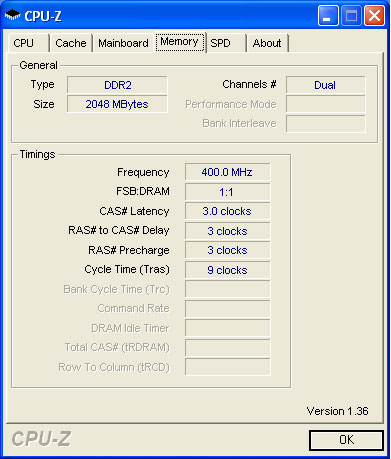
ASUS has earned our thanks for making the 965P chipset worth considering again. With overclocks up to 532 in our testing, with multipliers settable to x6 on all tested chips, and with multipliers purportedly also unlocked at the top on some formerly locked Conroe chips this BIOS upgrade has to be considered a must for any ASUS P5B Deluxe owner. For those considering a new Conroe board, the already desirable P5B has just moved to the head of the 965P class. The only feature missing now is support for CrossFire video configurations, which remains an advantage of the 975X for gaming enthusiasts.







